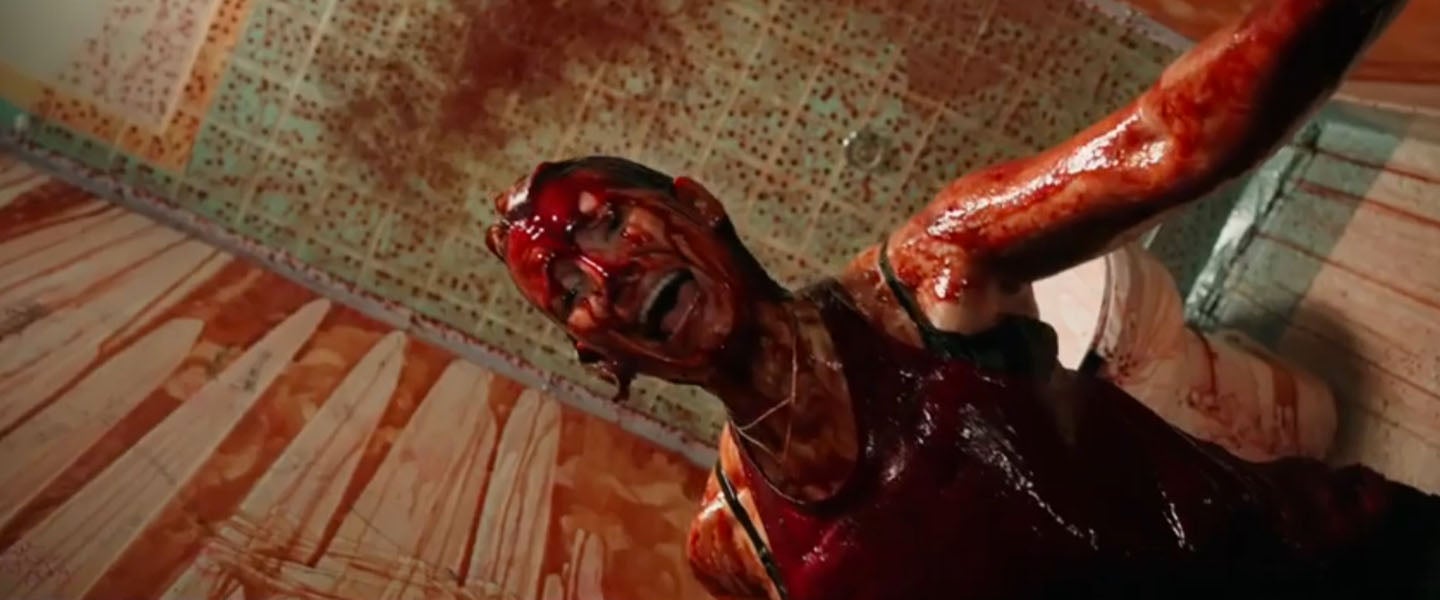Last year, while promoting the fascinating documentary Filmmaker, Stanley Kubrick’s longtime assistant Leon Vitali shed some light on the making of one of The Shining’s most famous scenes: the elevator filled with blood.
Speaking to Yahoo! Entertainment, Vitali discussed the weeks spent finding just the right consistency for the red stuff and the danger of filling an enclosed space with gallons of liquid. The shot could have gone wrong so easily and filming it proved so stressful that Kubrick, though never eager to put any aspect of his films in anyone else’s hands, left the set saying, “Keep an eye on it and tell me if anything goes wrong.” It didn’t go wrong, as we now know, and even Kubrick seemed pleased with it.
Which is a great story — but what happened next? Who cleaned up those gallons of fake blood? It’s a question that applies to many of horror’s most famous moments. Consider, for instance, the chest-bursting scene in Alien, or Johnny Depp’s fate in A Nightmare on Elm Street after he settles into his bed to watch Miss Nude America on TV — both mix the unsettling with the nauseating, both are impossible to forget and both must have left a tremendous mess after the directors yelled “cut.” Now, with IT Chapter Two in theaters, it’s hard not to wonder who gets to clean up that blood-drenched bathroom this time around.
Much of the time, especially on films without Kubrick-sized budgets, it’s those who made the mess possible in the first place. “If it’s a small family-style shoot, it’s all hands on deck,” says John Russell, who runs the self-described “mom-and-pop FX shop” Russell FX with his wife Sierra Russell. Their combined credits range from indie horror films like The Ritual to work on Narcos and NCIS. “Art department cleans the sets, we clean the actors,” he elaborates.
Makeup and FX artist Somica Spratley, who also works as an actor and director and whose credits range from the horror film Spiritus to the recent Marc Maron-starring indie Sword of Trust, confirms this division of labor. “Generally speaking, you clean up for your department,” Spratley says. “If it’s on the skin, the makeup team handles it. If it’s on the wardrobe, the set costumers come in. If it’s on a prop, then that’s the art department.” But sometimes the division breaks down. “On low-budget projects, people tend to help wherever needed,” Spratley says.
Different clean-up jobs present their own challenges, particularly when actors aren’t game. “It’s always a crap shoot,” says head of Ill Willed Productions Tate Steinsiek, an SFX and prosthetic makeup artist and filmmaker whose credits include The Amazing Spider-Man, Dragged Across Concrete and the new Satanic Panic. “Some actors are cool, some are squeamish. There are so many times I’m like, ‘Did you read the script?’”
Russell speaks of similar experiences. “They’re mostly game if they’re doing a horror film. If it’s a comedy or a drama with only one small bit to deal with, they may be less happy for it, but still ready for their ‘Nickelodeon moment,’” he says.
“However, you will come across the guy who signed up for the job, then wants to change the script each time it comes up,” he continues. “For instance, there was a movie we did where the lead actor was also an exec producer and couldn’t stand a drop of blood on him: It was scripted for him to get soaked while saving people, get stabbed, shot, etcetera. The climax of the movie would have left him a drenched red person. He just wasn’t having any of it, so we ended up having to lose most of the final battle and set the villain on fire, which might sound cool but was boring to watch. On the flip side, we’ve had movies where the actors couldn’t get enough blood — to the point we would almost run out of it — and were so happy to get disgusting for the sake of the film. Those are the good days.”
Whether they’re eager or not, cleaning up actors can be a delicate job, even in shoots without floods of viscera. “Preparation of the actor’s skin is always my first concern,” Spratley says. “The last thing you want to do is create any trauma to the skin, resulting in a difficult clean-up or removal process. For cleaning up the blood, I use a combination of specialty removers. Before that even, I apply Barbasol shaving cream — a little pro tip from the legendary Dick Smith.” Spratley’s tip of the hat to Smith — the man responsible for the stunning makeup work in films like Little Big Man, The Exorcist and Taxi Driver — is telling. Though the industry has changed, some of its central techniques span generations, and remain surprisingly low-tech.
That remains true when it comes to cleaning up a set, too, even when a shoot involves gushing fluids: Sometimes the best solution involves simple household cleaners. “There isn’t much you can do when it comes to tidal waves of blood,” Steinsiek says. “You can take a mop or paint roller and soak the floor and walls with watered-down dish soap so it cleans much faster, but that’s in environments that assume you can take a power washer and blast it. That obviously doesn’t work in someone’s home.”
Careful planning can help to minimize clean-up, however, and this also tends to involve low-tech, time-tested solutions. “In pre-production meetings we’ll try to square up with all departments about what will happen during a scene and how to prepare,” Russell says. “We address things such as, ‘Are there multiple costumes?,’ ‘Can we have a tarp covering the areas not on screen?’ and ‘Can there be a false floor such as a rug to soak up blood?’ The worst thing you can hear going into a scene is, ‘So first off, blood can’t get on anything here,’ and no one’s thought it through, but you’re meant to chop a dude in half and soak the other actors in his blood. You’d be surprised how often that comes up.”
Of course, some shoots are messier than others. “I personally prefer things on the more realistic side when it comes to bloody expulsions. But there are those types of directors who want a nosebleed to fill the room. I had one gig that required us to come back and repaint the room, so technically that clean-up took about four days,” Steinsiek recalls. He also notes, “Easily the messiest aspects are the blood gags.” Not that he’s averse to letting it bleed: “I use a lot of different devices — some are just a couple pumps from a bike pump, others [involve] 200PSI Compresser-filled blood cannons. [For] one of the scenes in Puppet Master: The Littlest Reich — the moment that Pinhead tears the arm off of the police officer — we used one of our favorites, ‘The Blood Goose.’ When you pull the trigger, it honks as the compression releases. We painted the entire room red in a second. It was amazing.”
But will such amazing images become a thing of the past? The introduction and popularization of CG effects has changed what horror movies can do while also, obviously, making cleaning up a horror set easier, since one great advantage of CG blood is that you don’t have to wipe down spatters on actors or sets. Yet those who work on the practical side of horror effects don’t seem all that concerned, and even express enthusiasm for CG.
“CGI and makeup effects both have their place and can certainly exist together,” Spratley says. “Both can be executed beautifully, and both can look like total shit. There’s something to having a physical prop or gag present, not to mention that it’s better interaction for the actors. In my opinion, I cannot see makeup effects ever becoming a lost art.” When I ask if he sees digital blood taking the place of practical fake blood, Russell suggests they both have a future, saying, “On tent poles, no doubt. No one can afford to spend three hours setting up a slow-mo, motion-controlled sequence of the protagonist having his girlfriend splattered in front of his eyes only to find out in playback that it didn’t quite sell. I support those digital moments. But for the real genre works, the practical elements won’t ever go away. The audience needs the viscera to feel connected.”
“I feel we’re slowly finding the middle ground that digital and practical work best as a couple,” says Sierra Russell, adding that productions aiming to land a PG-13 rating tend to favor the digital over the practical in order to ensure the “blood and viscera is appropriately regulated.” “There’s a balance between practical and digital that’s perfectly harmonized and allows the value of both sides of the coin to shine,” Steinsiek says. “But big caveman-fisted people will always come in and ensure there’s a sloppy version for us all to cringe at. That’s the most predictable thing about gore and horror movies in general: For every good one, there’s three bad, but we love them all.”
With that love comes a lot of work, however, particularly for those charged with making sure scenes of dismemberment, evisceration and other bloody business leaves no evidence behind. It’s work that only gets more complicated with lower budgets. “The problem on indie sets is, you’re always behind schedule and understaffed. That’s what makes this such a frequent circle of finger-pointing,” Steinsiek says, describing a typical shoot. “‘The next gag is a two-hour set-up, and the crew has already moved to that location to pre-light. The AD wants talent on set in [90 minutes] so you’re already behind schedule. The movie itself needs you to leave immediately and get to MUFX basecamp and begin the next application, and you only have one key and one second. If you leave your second [to clean up], the application goes slower. What do you do? This is generally the part where we explain to the second [assistant director] that, ‘You can either hate me now or later. We can leave and get the makeup ready for set, or I can leave a guy to clean this and delay set — your call.’ It’s a delicate dance.”
And without planning and sweat, that dance can leave behind a trail of bloody footprints.

